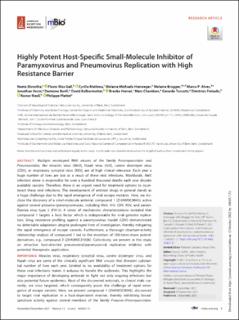Please use this identifier to cite or link to this item:
https://doi.org/10.21256/zhaw-25810| Publication type: | Article in scientific journal |
| Type of review: | Peer review (publication) |
| Title: | Highly potent host-specific small-molecule inhibitor of paramyxovirus and pneumovirus replication with high resistance barrier |
| Authors: | Shrestha, Neeta Gall, Flavio Max Mathieu, Cyrille Hierweger, Melanie Michaela Brügger, Melanie Alves, Marco P. Vesin, Jonathan Banfi, Damiano Kalbermatter, David Horvat, Branka Chambon, Marc Turcatti, Gerardo Fotiadis, Dimitrios Riedl, Rainer Plattet, Philippe |
| et. al: | No |
| DOI: | 10.1128/mBio.02621-21 10.21256/zhaw-25810 |
| Published in: | mBio |
| Volume(Issue): | 12 |
| Issue: | 6 |
| Page(s): | e0262121 |
| Issue Date: | 2021 |
| Publisher / Ed. Institution: | American Society for Microbiology |
| ISSN: | 2150-7511 |
| Language: | English |
| Subjects: | Paramyxovirus; Pneumovirus; Host-directed; Replication; Inhibitor; High resistance barrier |
| Subject (DDC): | 579: Microbiology 615: Pharmacology and therapeutics |
| Abstract: | Multiple enveloped RNA viruses of the family Paramyxoviridae and Pneumoviridae, like measles virus (MeV), Nipah virus (NiV), canine distemper virus (CDV), or respiratory syncytial virus (RSV), are of high clinical relevance. Each year a huge number of lives are lost as a result of these viral infections. Worldwide, MeV infection alone is responsible for over a hundred thousand deaths each year despite available vaccine. Therefore, there is an urgent need for treatment options to counteract these viral infections. The development of antiviral drugs in general stands as a huge challenge due to the rapid emergence of viral escape mutants. Here, we disclose the discovery of a small-molecule antiviral, compound 1 (ZHAWOC9045), active against several pneumo-/paramyxoviruses, including MeV, NiV, CDV, RSV, and parainfluenza virus type 5 (PIV-5). A series of mechanistic characterizations revealed that compound 1 targets a host factor which is indispensable for viral genome replication. Drug resistance profiling against a paramyxovirus model (CDV) demonstrated no detectable adaptation despite prolonged time of investigation, thereby mitigating the rapid emergence of escape variants. Furthermore, a thorough structure-activity relationship analysis of compound 1 led to the invention of 100-times-more potent-derivatives, e.g., compound 2 (ZHAWOC21026). Collectively, we present in this study an attractive host-directed pneumoviral/paramyxoviral replication inhibitor with potential therapeutic application. IMPORTANCE Measles virus, respiratory syncytial virus, canine distemper virus, and Nipah virus are some of the clinically significant RNA viruses that threaten substantial number of lives each year. Limited to no availability of treatment options for these viral infections makes it arduous to handle the outbreaks. This highlights the major importance of developing antivirals to fight not only ongoing infections but also potential future epidemics. Most of the discovered antivirals, in clinical trials currently, are virus targeted, which consequently poses the challenge of rapid emergence of escape variants. Here, we present compound 1 (ZHAWOC9045), discovered to target viral replication in a host-dependent manner, thereby exhibiting broad-spectrum activity against several members of the family Pneumo-/Paramyxoviridae. The inability of viruses to mutate against the inhibitor mitigated the critical issue of generation of escape variants. Importantly, compound 1 was successfully optimized to a highly potent variant, compound 2 (ZHAWOC21026), with a promising profile for pharmacological intervention. |
| URI: | https://digitalcollection.zhaw.ch/handle/11475/25810 |
| Fulltext version: | Published version |
| License (according to publishing contract): | CC BY 4.0: Attribution 4.0 International |
| Departement: | Life Sciences and Facility Management |
| Organisational Unit: | Institute of Chemistry and Biotechnology (ICBT) |
| Published as part of the ZHAW project: | Morbillivirus cell entry machinery: mechanisms, structures and antiviral drug discovery |
| Appears in collections: | Publikationen Life Sciences und Facility Management |
Files in This Item:
| File | Description | Size | Format | |
|---|---|---|---|---|
| 2021_Shrestha-etal_Highly-potent-host-specific-small-molecule-inhibitor-paramyxovirus.pdf | 2.39 MB | Adobe PDF |  View/Open |
Show full item record
Shrestha, N., Gall, F. M., Mathieu, C., Hierweger, M. M., Brügger, M., Alves, M. P., Vesin, J., Banfi, D., Kalbermatter, D., Horvat, B., Chambon, M., Turcatti, G., Fotiadis, D., Riedl, R., & Plattet, P. (2021). Highly potent host-specific small-molecule inhibitor of paramyxovirus and pneumovirus replication with high resistance barrier. mBio, 12(6), e0262121. https://doi.org/10.1128/mBio.02621-21
Shrestha, N. et al. (2021) ‘Highly potent host-specific small-molecule inhibitor of paramyxovirus and pneumovirus replication with high resistance barrier’, mBio, 12(6), p. e0262121. Available at: https://doi.org/10.1128/mBio.02621-21.
N. Shrestha et al., “Highly potent host-specific small-molecule inhibitor of paramyxovirus and pneumovirus replication with high resistance barrier,” mBio, vol. 12, no. 6, p. e0262121, 2021, doi: 10.1128/mBio.02621-21.
SHRESTHA, Neeta, Flavio Max GALL, Cyrille MATHIEU, Melanie Michaela HIERWEGER, Melanie BRÜGGER, Marco P. ALVES, Jonathan VESIN, Damiano BANFI, David KALBERMATTER, Branka HORVAT, Marc CHAMBON, Gerardo TURCATTI, Dimitrios FOTIADIS, Rainer RIEDL und Philippe PLATTET, 2021. Highly potent host-specific small-molecule inhibitor of paramyxovirus and pneumovirus replication with high resistance barrier. mBio. 2021. Bd. 12, Nr. 6, S. e0262121. DOI 10.1128/mBio.02621-21
Shrestha, Neeta, Flavio Max Gall, Cyrille Mathieu, Melanie Michaela Hierweger, Melanie Brügger, Marco P. Alves, Jonathan Vesin, et al. 2021. “Highly Potent Host-Specific Small-Molecule Inhibitor of Paramyxovirus and Pneumovirus Replication with High Resistance Barrier.” mBio 12 (6): e0262121. https://doi.org/10.1128/mBio.02621-21.
Shrestha, Neeta, et al. “Highly Potent Host-Specific Small-Molecule Inhibitor of Paramyxovirus and Pneumovirus Replication with High Resistance Barrier.” mBio, vol. 12, no. 6, 2021, p. e0262121, https://doi.org/10.1128/mBio.02621-21.
Items in DSpace are protected by copyright, with all rights reserved, unless otherwise indicated.